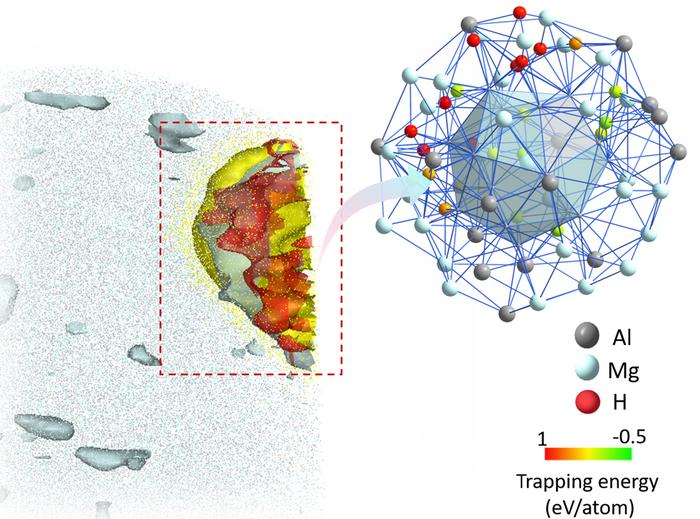In an era where sustainability and efficiency are driving forces behind material innovation, the field of aluminium alloys is experiencing a significant breakthrough. Researchers at the Max Planck Institute for Sustainable Materials (MPI-SusMat) have unveiled a novel alloy design strategy that addresses a persistent challenge in the use of aluminium in hydrogen-related applications. Traditional aluminium alloys have long been prized for their lightweight and corrosion-resistant properties, making them prime candidates for a low-carbon economy. However, a major impediment to their widespread use has been susceptibility to hydrogen embrittlement, leading to cracking and failure when exposed to hydrogen environments.
Hydrogen embrittlement is a phenomenon that compromises the structural integrity of metals, particularly in the context of high-strength alloys. This has posed a barrier to the utilization of aluminium in crucial applications such as lightweight vehicles and storage tanks for green hydrogen. Until now, researchers have struggled to create alloys that maintain strength while also exhibiting resistance to hydrogen embrittlement. The new research offers a promising solution, setting the stage for aluminium components that are not only strong but also safe for hydrogen applications.
The core of this breakthrough lies in a sophisticated precipitation strategy involving the incorporation of scandium in aluminium-magnesium alloys. This strategy employs a two-step heat treatment process, meticulously engineered to create dual nanoprecipitates within the alloy. The primary nanoprecipitate, Al3Sc, is the first to form, followed by the in-situ development of a shell constituted by a more complex Al3(Mg,Sc)2 phase. This innovative design allows for remarkable distribution of these nanoprecipitates throughout the metal matrix, creating a dual-action effect: the Al3(Mg,Sc)2 phase actively traps hydrogen, while the Al3Sc particles enhance the overall strength of the alloy.
Professor Baptiste Gault, a leading figure in the study, underscores the significance of this dual nanoprecipitate structure in his assertion that the new alloy fundamentally resolves the trade-off between strength and hydrogen resistance that has historically plagued the industry. The results of their investigative work are compelling, revealing a staggering 40% increase in strength and a five-fold enhancement in resistance to hydrogen embrittlement when compared to traditional scandium-free alloys. This dual benefit is anticipated to enable the production of aluminium components that not only meet but exceed current industry standards in automotive and energy applications.
Moreover, the researchers achieved an unprecedented record in tensile elongation under hydrogen-charged conditions. Their tested aluminium alloys exhibited a remarkable elongation of up to 7 ppmw, an indication of enhanced ductility and resilience under hydrogen exposure. Such revelations provide invaluable insights into the atomic-level dynamics of the alloy, with atom probe tomography being instrumental in validating the mechanistic role of the Al3(Mg,Sc)2 phase in hydrogen trapping. The innovative use of advanced microscopy techniques has shed light on the intricate interactions responsible for the alloy’s enhanced properties.
The commitment to translating these laboratory findings into practical applications cannot be overstated. The researchers have rigorously tested their alloy design across multiple aluminium alloy systems, demonstrating its versatility and effectiveness. More importantly, they took significant strides toward scalability, employing water-cooled copper mould casting and thermomechanical processing techniques that align with contemporary industrial practices. This paves the way for a new generation of aluminium materials that not only fulfills the demands of future hydrogen-powered economies but does so safely and effectively.
The collaborative research initiative highlights the importance of international partnerships in addressing complex challenges in material science. Researchers from Xi’an Jiaotong University and Shanghai Jiao Tong University in China contributed significantly to the study. Their collaborative efforts underscore the notion that overcoming scientific barriers often requires a united global approach, pooling resources and expertise to foster innovation and progress.
As the world strives to reduce carbon emissions and transition towards sustainable energy solutions, this novel alloy technology presents an auspicious opportunity for the tree-hugging and tech-savvy communities. By optimizing the properties of aluminium, this research addresses critical industry needs and holds promise for revolutionizing the hydrogen economy. The implications extend beyond materials science; they touch on environmental sustainability, energy independence, and the future of mobility.
In addition to its significance in the hydrogen economy, the development of these advanced aluminium alloys bears relevance to various industries. Lightweight yet strong materials may transform sectors ranging from automotive to aerospace, manufacturing, and infrastructure. Companies that harness the advantages of this research may gain a competitive edge, positioning themselves as leaders in the increasingly important field of sustainable materials.
In conclusion, the development of hydrogen-resistant aluminium alloys represents a watershed moment in material science, one that harmonizes the dual demands of strength and environmental sustainability. The innovative strategies employed by researchers from MPI-SusMat and their partners not only offer exciting potential for the future of hydrogen applications but also signal a new chapter in the quest for sustainable materials. As these findings circulate through the scientific community and industry, their impact is likely to resonate far beyond the laboratory, shaping the trajectory of materials science and engineering for years to come.
Subject of Research: Hydrogen-resistant aluminium alloys
Article Title: Structurally complex phase engineering enables hydrogen-tolerant Al alloys
News Publication Date: 30-Apr-2025
Web References: http://dx.doi.org/10.1038/S41586-025-08879-2
References: Nature
Image Credits: Adapted from: Nature; DOI:10.1038/S41586-025-08879-2
Keywords
Aluminium alloys, hydrogen embrittlement, nanoprecipitates, strength, sustainability, material science, hydrogen economy, atom probe tomography.
Tags: aluminium alloys innovationaluminium in hydrogen applicationscorrosion resistance in metalsgreen hydrogen storage technologieshigh-strength aluminium developmenthydrogen embrittlement solutionslightweight vehicle applicationsMax Planck Institute researchovercoming hydrogen-related challengesprecipitation strategy in metallurgystructural integrity of alloyssustainable material design





